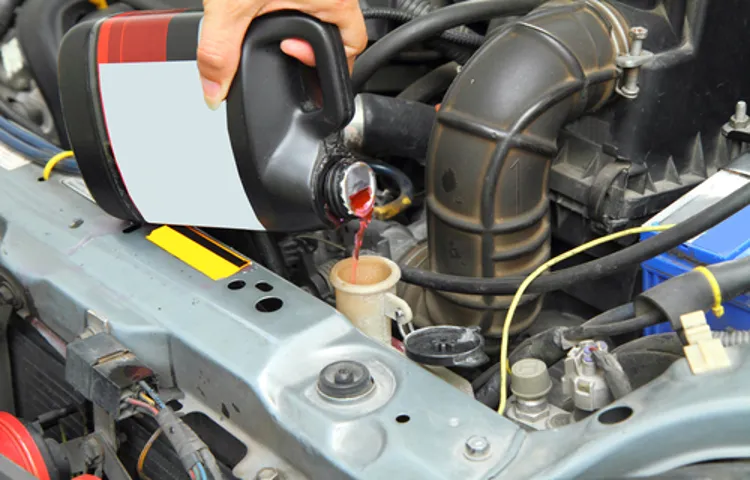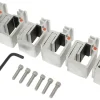It’s crucial to keep your car’s engine running smoothly, which is why routine maintenance is essential. One essential aspect of maintenance is ensuring that the coolant levels remain topped up. However, many drivers are left in the dark when it comes to how frequently they should top up coolant in their vehicle.
Are you one of those wondering how often to top up coolant? Well, stay glued to this post, and we will tell you all you need to know about maintaining your car’s coolant level. Understanding how regularly you should refill the coolant in your car can help prevent engine damage, ensuring your car runs efficiently and lives a long life. Let’s dive in and find out together!
Table of Contents
Understanding Your Vehicle’s Cooling System
One of the most critical systems in your vehicle is the cooling system, which helps regulate engine temperature and keeps it from overheating. The cooling system works by circulating coolant through the engine to absorb and transfer heat. Over time, coolant levels can decrease due to evaporation, leaks, or even just regular use.
As a result, it’s important to check and top up your coolant levels every 6-12 months or as recommended by your vehicle’s manufacturer. Checking your car’s coolant levels is simple and an important part of regular vehicle maintenance. Simply pop the hood, locate the coolant reservoir, and check the level against the minimum and maximum marks on the side.
If the coolant is low, add the recommended type of coolant specified in your owner’s manual until it reaches the maximum level. Regularly topping up your coolant levels can help prevent breakdowns and avoid costly repairs in the long run.
Identifying the Coolant Reservoir
When it comes to the cooling system of your vehicle, the coolant reservoir plays a crucial role in maintaining a consistent temperature. It’s not hard to locate the coolant reservoir, but it’s essential to identify it correctly to avoid confusion. The coolant reservoir is typically a translucent plastic container located near the radiator.
It’s usually marked with low and high indicators, indicating the level of coolant inside the reservoir. Maintaining the proper level of coolant in the reservoir is crucial to keep your engine cool and prevent it from overheating. Checking the coolant reservoir regularly and topping it off when necessary is an essential part of maintaining your vehicle’s cooling system.
Remember to ensure that the engine is cool before attempting to check or refill the coolant reservoir to avoid burns. In conclusion, understanding your vehicle’s cooling system and regularly checking the coolant reservoir can save you from costly repairs and keep your engine running smoothly.
Checking the Coolant Level
If you want to ensure that your vehicle runs smoothly, you need to understand its cooling system. This system plays an important role in maintaining the engine’s temperature at an optimal level, preventing it from overheating. One of the key components of the cooling system is the coolant, which absorbs heat from the engine and carries it to the radiator, where it dissipates.
To check the coolant level, locate the overflow tank under the hood. Most modern cars have a transparent overflow tank, making it easier to see the coolant level. The coolant level should be between the minimum and maximum marks, and it’s important to check this while the engine is cold.
If the coolant level is low, refill it with a 50/50 mixture of coolant and water. Neglecting to maintain the coolant level can lead to serious engine damage, resulting in costly repairs. By keeping a close eye on your vehicle’s cooling system and ensuring the coolant level is adequate, you can extend the life of your engine and avoid costly breakdowns.
Factors That Affect Coolant Consumption
It’s important to keep an eye on your coolant levels and top up as needed to prevent damage to your engine. However, how often to top up coolant is dependent on several factors. One major factor is the age and condition of your vehicle’s radiator.
If it’s old and corroded, it may consume more coolant than a newer radiator. Another factor is the outside temperature. During the summer months, coolant tends to evaporate more quickly, so you may need to top up more often.
Your driving habits also play a role; stop-and-go city driving can use up more coolant than highway driving. Additionally, if you notice any leaks in your system, it’s important to address them as soon as possible to prevent coolant loss. Overall, it’s important to keep an eye on your coolant levels and assess how frequently you need to top up based on these factors.
Age and Condition of the Cooling System
Coolant Consumption As your vehicle ages, its cooling system becomes more susceptible to leaks and failures. This is due to the constant exposure to heat, pressure, and other elements that gradually wear down the system over time. Additionally, extreme weather conditions, such as high temperatures or freezing temperatures, can also affect your coolant consumption.
If your car’s cooling system is not maintained properly, it can cause leaks, blockages, and other issues that lead to coolant loss. To avoid this, it’s essential to regularly check your car’s coolant levels and have your coolant system inspected by a professional mechanic. This will help you catch any potential problems early on before they become major issues and ensure your car runs smoothly and efficiently.
Remember, a well-maintained cooling system will not only improve your car’s performance but also extend its lifespan.
Driving Conditions and Environment
Coolant Consumption. Driving conditions and environment are two of the most crucial factors that significantly affect coolant consumption. Because of the varying weather conditions, driving through different terrains, and driving styles of different drivers, the use of coolant in a vehicle varies.
In hotter climates, the engine requires more coolant to keep the engine cool. Similarly, driving on mountainous terrains with steep inclines puts an extra load on the engine, requiring more coolant to maintain the engine’s temperature. Additionally, harsh driving habits like constant acceleration and deceleration can cause the engine to work harder, thereby needing more coolant to keep the engine from overheating.
On the other hand, driving styles that promote fuel efficiency like maintaining the recommended speed limit, and avoiding hard acceleration can reduce the amount of coolant required. Consequently, regardless of environmental factors, driving habits can also significantly impact coolant consumption. To ensure optimal coolant consumption, it is advisable to drive defensively, maintain recommended speed, and avoid heavy loads, among other road etiquettes.
Coolant Type and Quality
When it comes to engine coolant, there are various factors that can affect its consumption. One major factor is the type and quality of coolant being used. Different coolant types have different lifespans and recommended replacement intervals.
Additionally, using a low-quality or incorrect coolant can lead to corrosion and other issues that can increase the overall consumption of coolant. It’s important to always use the recommended coolant type and to only use high-quality products. This will not only help maintain proper engine function, but it will ultimately reduce the amount of coolant needed and save you money in the long run.
Don’t skimp on coolant quality – it’s a small investment that can make a big difference in your vehicle’s performance.
Recommended Coolant Maintenance Schedule
If you want to keep your engine running smoothly, you need to make sure that your coolant is always topped up. The recommended maintenance schedule for coolant varies depending on your make and model, but as a general rule, you should top up your coolant every 6 months or every 10,000 miles. It’s important to note that you should also do a full coolant flush and replace the coolant every 2-3 years or every 30,000 miles.
Neglecting your coolant can cause serious damage to your engine, so be sure to keep on top of your maintenance schedule. A good tip is to check your owner’s manual or consult with a professional mechanic to ensure that you are following the proper coolant maintenance schedule for your specific vehicle. Remember, taking care of your car’s coolant system is key to keeping your engine healthy and running.
Consult Your Vehicle’s Owner’s Manual
When it comes to maintaining your vehicle’s cooling system, it’s important to consult your owner’s manual for a recommended maintenance schedule. Your manual will provide specific details on the type of coolant your vehicle requires and how often it needs to be changed. Neglecting your coolant can lead to engine overheating, which can cause serious damage to your car.
So, it’s essential to stay on top of your coolant maintenance to avoid any huge repair bills down the line. Generally, coolant should be changed every two to five years, but the specific timeline and type of coolant needed will vary by manufacturer and model. Checking in with your owner’s manual is the best way to ensure you’re properly taking care of your vehicle’s cooling system to keep your car running smoothly and efficiently.
General Guidelines for Most Vehicles
If you want your vehicle’s engine to function smoothly, it is crucial to maintain its coolant system. Experts recommend that you should flush and refill your coolant every 40,000 to 100,000 miles. However, you may need to replace your coolant more frequently if you drive your vehicle under extreme conditions.
On average, you may need to replace your coolant every three to five years. It is important to use the right type of coolant for your vehicle. Your vehicle’s owner’s manual will indicate which type of coolant will work best for it.
You can also consult an automotive technician or a reputable mechanic to help you choose the right coolant. If you want to ensure that your vehicle’s coolant system is in good working condition, you should inspect it regularly for signs of leakage, and you should check its level periodically. Remember, your coolant system plays an essential role in your vehicle’s health – don’t neglect it!
Conclusion and Final Tips
In conclusion, topping up your coolant should be done as often as you would add extra cheese to your pizza – it’s all about personal preference and the specific needs of your vehicle. So, keep an eye on your coolant levels, and if you notice any changes or warning signs, don’t hesitate to give your mechanic a call. After all, much like a well-made pizza, a properly functioning vehicle depends on the right ingredients and attention to detail.
“
FAQs
Why is it important to top up coolant in a car?
Coolant helps regulate the temperature of the engine and prevents it from overheating, which can cause major damage and potentially lead to a breakdown.
How often should coolant be topped up in a car?
It is recommended to check coolant levels and top up as needed every 12 months or 10,000 miles, whichever comes first.
What is the proper way to top up coolant in a car?
First, ensure the engine is cool. Then, locate the coolant reservoir and add the appropriate type and amount of coolant as specified in the vehicle’s manual or on the reservoir itself.
Can I use any type of coolant to top up my vehicle’s system?
No, it’s important to use the type of coolant specified in your vehicle’s manual or on the coolant reservoir to ensure compatibility and prevent potential damage.
How can I tell if my vehicle needs more coolant?
You can check the coolant level by looking at the markings on the coolant reservoir or by using a dipstick specially designed for coolant. If it falls below the minimum level, it’s time to add more.
What should I do if my vehicle’s coolant level keeps dropping, even after I’ve topped it up?
This could indicate a leak in the coolant system, which should be checked by a mechanic as soon as possible to prevent further damage.
What are some signs that my car’s coolant system may be malfunctioning?
Signs of a malfunctioning coolant system may include the engine overheating, the temperature gauge fluctuating, coolant leaks, or a sweet smell coming from the engine bay. If you notice any of these signs, it’s important to have your vehicle inspected by a professional.



